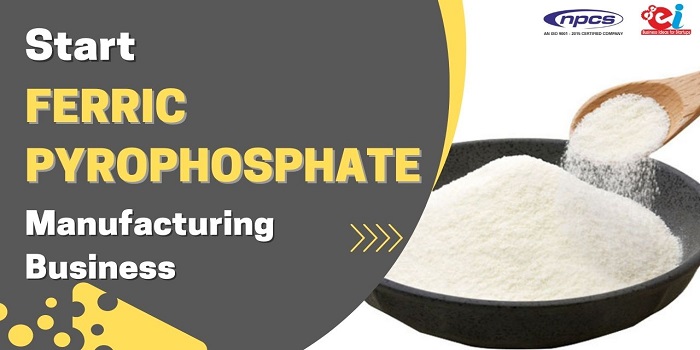Ferric Pyrophosphate:
Ferric pyrophosphate is an inorganic compound that is a Fe3+ and P2O5. The chemical formula of ferric pyrophosphate can be written as (FePO) or FePO4 • 5H2O. Ferric pyrophosphate is used to bind phosphates with iron so it can be added to fertilizers.
It is also used in water treatment facilities to remove phosphate from water so it can then be reused by other industries. It’s also used as a pigment for plastics and paints.
IT has many uses due to its ability to bind phosphates with iron ions making it a very versatile product.
Visit this Page for More Information: Start a Business in Chemical Industry Projects
Applications of Ferric Pyrophosphate:
Pigments, phosphorescent materials (for example, watch dials), mordents (typically in combination with tannic acid), flocculants, and sequestering agents are all examples of ferric pyrophosphate compounds. It’s known as Iron Blue or Prussian Blue when used as a pigments or colourant.
It’s also employed as a polymerization activator for vinyl monomers like acrylates. It’s also regularly used with sulfuric acid to generate hydrogen peroxide and peroxyacids such per acetic acid. It is used as a phenol completing agent in organic chemistry.
Business Plan: Ferric Pyrophosphate Production Business
It’s also used to remove phosphates from waste streams before they’re discharged into rivers and lakes in water treatment plants. Ion exchange resins are subsequently used to remove the phosphate complexes from the solution.
In wastewater treatment applications such as activated sludge systems, trickling filters, and sedimentation basins, it is used as a particulate matter flocculant. It is used to coagulate and precipitate fine suspended particulates from water using calcium hydroxide or aluminium sulphate. Filtration or centrifugation can then be used to remove the solid that has formed. It’s also used to filter out dissolved iron from water.
Manufacturing Process:
In a furnace, iron and phosphate rock are mixed together to begin the production process. A blast furnace is employed, which is a massive equipment that uses air forced into it to create high temperatures. At 1,700 degrees Fahrenheit, the iron and phosphate rock are fused together (930 degrees Celsius).
After that, more fuel is added to raise the temperature to 2,000 degrees Fahrenheit (1,100 degrees Celsius) and melt more iron. Ferric pyrophosphate is formed when the hotter molten metal combines with even more phosphate rock. Crystals form as it cools.
These crystals are then processed into a powder and sold as fertilizer or other items. It takes around two weeks to make enough ferric pyrophosphate to make a batch of dry fertiliser. Ferric pyrophosphate is found in around four pounds (2 kilogrammes) per tonne of dry fertiliser.
Download PDF: Ferric Pyrophosphate Manufacturing Business Plan | Startup Business Ideas
The Benefits of Starting a Ferric Pyrophosphate Manufacturing Business include the following:
You should investigate the ferric pyrophosphate producing industry. It’s a difficult sector with high entry hurdles, thus it’s a niche market that only experienced entrepreneurs are interested in. Other metal phosphates, such as calcium, magnesium, and zinc phosphates, can be made using the same procedure.
As a result of their usage in agriculture, demand for these commodities has gradually increased in recent years. By creating a ferric pyrophosphate manufacturing Industry, you may profit from these increasing markets while also supplying your consumers with a product that aids in agricultural production improvement and fertilizer expense reduction.
Related Feasibility Study Reports: Chemicals (Organic, Inorganic, Industrial) Projects
Market Outlook:
In 2017, ferric pyrophosphate accounted for more than half of the total market share. Increased demand for FePO4 will be driven by key uses such as iron supplements for illness prevention such as anaemia, fortification in infant cereals and other drink powders, and a high presence of iron bioavailability.
The ferric pyrophosphate market will be driven by a growth in the number of health problems that occur each year as a result of dietary and vitamin deficiencies in infants, children, and adults. By 2024, consumption of food and beverage is predicted to reach 60 kilo tonnes.
Read our Books Here: Chemical Technology (Organic, Inorganic, and Industrial), Fine Chemicals
FePO4 will thrive thanks to rising customer demand and a diverse variety of tastes in the food and beverage industry. The industry will expand as people become more aware of their daily nutritional intake and demand for dietary supplements rises.
Through 2024, fertilizer use will increase at a rate of more than 5% per year. Rapid advancements, notably in the agriculture sector, will enhance the industry’s scale as a result of population growth.
Increased agricultural and fertilizer R&D investments, as well as the development of novel and enhanced agrochemical compounds for high-quality crop production, will assist the animal feed and food industries. As a result, the iron phosphate market’s overall size is impacted.
Read Similar Articles: Chemical Industry
The global iron phosphate market will expand due to the growing expansion of the agriculture, pharmaceutical, and food and beverage industries. The amount of arable land accessible grows in tandem with the world’s population, extending the area of fertilizer application.
Pesticide penetration will be aided by increased agricultural insect concerns and the release of new pesticide types. Growing crop demand will propel the company forward, as will increased agricultural R&D spending.
Key Players:
- Sudeep Pharma Pvt. Ltd.
- Crest Industrial Chemicals
- Imperial Chemorporation
- Spectrum Laboratory Products (spectrum chemical manu. Corp)
- Merck
- Jost Chemical
- American Elements
- Hefei Asialon Chemical
- Aarvee Chemicals
- Zhengzhou Ruipu Biological Engineering
- Charkit Chemical Corporation
- ILVE Chemicals
- Pd Navkar Bio-chem
See More Links:
- Start a Business in Asia
- Start a Business in Potential Countries for Doing Business
- Best Industry for Doing Business
- Business Ideas with Low, Medium & High Investment
- Looking for Most Demandable Business Ideas for Startups
- Startup Consulting Services
- Start a Business in Africa
- Start a Business in India
- Start a Business in Middle East
- Related Videos
- Related Books
- Related Projects
- Related Market Research Reports

